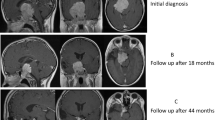Abstract
Myasthenia gravis (MG) is an autoimmune disease affecting neuromuscular transmission that manifests with muscle weakness and typically involves the eye muscles, often producing diplopia and ptosis. Recent studies suggest that hyperprolactinaemia may have a role in the development of MG, although its association with prolactinoma is extremely rare. We report the unusual case of a 71-year-old male affected with macroprolactinoma, who presented at our Center 2 weeks after starting cabergoline treatment because of acute onset of headache, diplopia, and ptosis. On admission, he presented with drowsiness, dropped head, swallowing impairment and bilateral ptosis, which rapidly worsened. Based on clinical manifestation and history, emergency surgery was performed on suspicion of pituitary apoplexy (PA), the typical complication occurring in patients with macroadenomas who present these symptoms. No pituitary haemorrhage was found. The symptoms initially resolved after surgery, but soon returned and worsened day by day, especially in the evening, despite the increase of cortisone replacement doses. MG was thus suspected and confirmed by the detection of antibodies to the acetylcholine receptor. Pyridostigmine was started with prompt improvement of neurological symptoms. In conclusion, although very rare, MG should be considered in the differential diagnosis of patients with macroprolactinomas and suggestive neurological symptoms in order to provide early and appropriate treatment. The role of hyperprolactinaemia in MG onset and evolution is also discussed.


Similar content being viewed by others
References
Glezer A, Bronstein MD (2015) Prolactinomas. Endocrinol Metab Clin N Am 44(1):71–78
Raverot G, Jacob M, Jouanneau E et al (2009) Secondary deterioration of visual field during cabergoline treatment for macroprolactinoma. Clin Endocrinol 70:588–592
Leong KS, Foy PM, Swift AC, Atkin SL, Hadden DR, MacFarlane IA (2000) CSF rhinorroea following treatment with dopamine agonists for massive invasive prolactinomas. Clin Endocrinol 52:43–49
Chng E, Dalan R (2013) Pituitary apoplexy associated with cabergoline therapy. J Clin Neurosci 20(12):1637–1643
Zoli M, Milanese L, Faustini-Fustini M et al (2017) Endoscopic endonasal surgery for pituitary apoplexy: evidence on a 75-case series from a tertiary care center. World Neurosurg 106:331–338
Gilhus NE (2016) Myasthenia gravis. N Engl J Med 375(26):2570–2581
Lee JI, Jander S (2017) Myasthenia gravis: recent advances in immunopathology and therapy. Expert Rev Neurother 17(3):287–299
Rajasekaran S, Vanderpump M, Baldeweg S et al (2011) UK guidelines for the management of pituitary apoplexy. Clin Endocrinol 74(1):9–20
Baldeweg SE, Vanderpump M, Drake W et al (2016) Society for endocrinology endocrine emergency guidance: emergency management of pituitary apoplexy in adult patients. Endocr Connect 5(5):G12–G15
Cahill DFW, Sellman MS, Salcman M (1980) Prolactin-secreting adenoma in a myasthenic patient. Neurosurg 6:310–313
Tsinzerling N, Pirskanen R, Matell G et al (2006) Raised prolactin levels in myasthenia gravis : two case reports and a study of two patient populations. Acta Neurol Scand 114:346–349
Harris SM, Leong HM, Chowdhury R, Ellis C, Brennan J, Scobie IN (2014) Concomitant myasthenia gravis and macroprolactinoma: the immunomodulatory role of prolactin and its potential therapeutic use. Endocrine 45(1):9–14
Savino W (2017) Prolactin: an immunomodulator in health and disease. Front Horm Res 48:69–75
Yu-Lee LY (2002) Prolactin modulation of immune and inflammatory responses. Recent Prog Horm Res 57:435–455
Garchon HJ (2003) Genetics of autoimmune myasthenia gravis, a model for antibody-mediated autoimmunity in man. J Autoimmun 21:105–110
Yang M, Huang L, Liu W, Sheng Z, Xie H, Liao E (2008) Prolactin may be a promising therapeutic target for myasthenia gravis: hypothesis and importance. Med Hypoth 70:1017–1020
Author information
Authors and Affiliations
Corresponding author
Ethics declarations
Conflict of interest
The authors declare that they have no conflict of interest.
Rights and permissions
About this article
Cite this article
Zoli, M., Guaraldi, F., Faustini, M. et al. Myasthenia gravis imitating pituitary apoplexy in macroprolactinoma. Hormones 17, 423–426 (2018). https://doi.org/10.1007/s42000-018-0036-2
Received:
Accepted:
Published:
Issue Date:
DOI: https://doi.org/10.1007/s42000-018-0036-2




